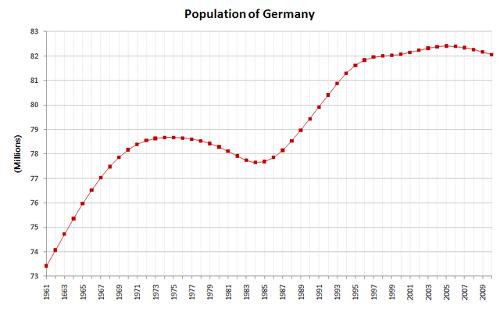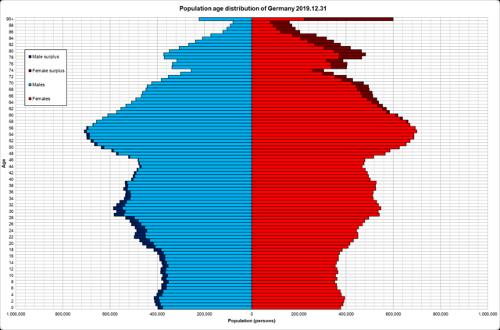GERMANY
Population

Population
Cities in GERMANY
| Berlin | Cologne | Dortmund |
| Frankfurt | Hamburg | Heidelberg |
Popular destinations GERMANY
| Bavaria |
Population
In 2024, there were about 84 million inhabitants in Germany. Germany has the largest population of the countries of the European Union. Germany is one of the most densely populated countries in Europe, with just under 240 inhabitants per km2. Only Belgium, the Netherlands and the United Kingdom have a higher population density.
The most densely populated areas are the metropolises (Berlin, Hamburg and Munich), the Rhine-Westphalia industrial area, the Rhine-Main area, the Rhine-Neckar area and the Stuttgart area, the Leipzig-Halle industrial area, the Chemnitz-Zwickau area and the surroundings of Dresden. More than 78% of the total population lives in cities or urban areas.
The largest population concentration, approx. 11 million people, is in the Ruhr area, where cities such as Essen, Duisburg and Dortmund are so close to each other that they merge with no clear boundary. Of the more than 80 million inhabitants, about 15 million people live in the former East Germany and another 3.5 million in Berlin.
A relatively large number of people live in small villages of less than 5000 inhabitants and in the many medium-sized cities of 100,000-500,000 inhabitants.
The largest German cities are:
- Berlin 3,574,000
- Hamburg 1,788,000
- Munich 1,576,000
- Cologne 1,144,000
About 60,000 Danish-speaking Germans of Danish origin live in the north of Schleswig-Holstein. The same number has the Slavic Sorbian minority in the east (Lansitz). Approx. 30% of the foreigners are Turks, plus Yugoslavs, Italians, Greeks, Poles, Bosniaks and Croats. Due to the large flow of refugees to Germany from the end of the eighties, from the Eastern bloc countries, in particular East Germany, Yugoslavia, Russia, but also from Africa and Asia, the right of asylum was restricted in 1993. Number of inhabitants Germany from 1961Photo: User:Valérie75 CC 2.0 Generic no changes made
Number of inhabitants Germany from 1961Photo: User:Valérie75 CC 2.0 Generic no changes made
Population composition, population growth and net migration have undergone a completely different development in East and West Germany after the German unity in 1991. First, the fall of the Berlin Wall triggered a large flow of migrants from East to West Germany. Furthermore, the population grew strongly after unification due to the influx of foreign migrants. An estimated 8 million inhabitants of the total population have a foreign nationality.
Finally, the birth rate in East Germany fell sharply. For example, 45% fewer children were born in 1991 than in 1988. Since 1994, this number has increased again. Nevertheless, the aging population in East Germany is still continuing and the population is still declining. In 1997 there were 1 million fewer people living there than in 1989.
Population data Germany (2024)
- Birth rate 8.9 per 1000 inhabitants
- Mortality rate 12 per 1,000 residents
- Average life expectancy 81,9.8, men 79.56and women 84.4
- Population growth -0.12%
- Population structure:
- 0-14 years 13,8%
- 15-64 years 62,5%
- 65+ 23,7%
 Population pyramid Germany 2019-12-31Photo: Sdgedfegw CC 4.0 International no changes made
Population pyramid Germany 2019-12-31Photo: Sdgedfegw CC 4.0 International no changes made
East Germany
The population structure in the former East Germany or the “neue Länder” is very unbalanced. The ages of around 50 and 80 years are underrepresented due to the two world wars. There has also been a decline in births between the ages of 30 and 40 as a result of the introduction of the contraceptive pill.
By 1975, the number of births fell significantly due to the authorization of abortion. This was followed by a birth-stimulating policy by the government, whereby the number of births increased again and the 10-20 year olds are strongly represented in the East German population..
West Germany
Naturally, the influences of both world wars can also be found in the former West Germany. The differences in population structure are mainly in the period after 1975. Birth control was much less in West Germany than in East Germany, so the ages between 10 and 20 years are much better represented in West Germany and the population pyramid has a more regular course.
Sources
Ayer, E.H. / Germany
Lucent Books
Egert-Romanowska, J. / Duitsland
Van Reemst
Europese Unie : vijftien landendocumentaties
Europees Platform voor het Nederlandse Onderwijs
Mark, D.F.W. van der / De Bondsrepubliek Duitsland voor en na 1990 : geschiedenis, politiek, economie en ruimtelijke ontwikkeling
Landensurveys
Tatsachen über Deutschland
CIA - World Factbook
BBC - Country Profiles
Copyright: Team The World of Info